Typhoon ‘Nina’ pounds Bicol
Packing peak winds of 185 kilometers per hour, Typhoon “Nina” (internationally named Nock-ten after a bird found in Laos) pounded the Bicol region on Sunday night, sending thousands of coastal residents fleeing to evacuation centers, stranding travelers on ports and buses and spoiling Christmas celebrations in endangered regions.
Officials warned 2.5-meter high waves and landslides posed the biggest threats as Nina closed in on the eastern section of Luzon and nearby islands.
“We went around with megaphones and gave instructions to our people to eat breakfast, pack and board the military trucks,” said Alberto Lindo, an official of Alcala, a farming village of 3,300 people near the active Mayon volcano.
“There are large ash deposits on the slopes. Heavy rain can dislodge them and bury our homes in mud,” he said.
Philippine and international weather services said Nina was set to hit Catanduanes on Sunday night before reaching the rest of the main island of Luzon on Monday.
Article continues after this advertisement
LEAVING HOME ON CHRISTMAS Residents of Daraga, Albay province, are given a ride in the back of a truck after heavy and incessant rains brought by Typhoon “Nina” (international name: Nock-ten) drive them to evacuate to higher ground. —AFP
Inquirer reporter Fernan Gianan reported from the Catanduanes capital of Virac that heavy rain was hammering the area and strong winds had felled trees in the city center. “We can see lightning flashes every 10 seconds or so, we must be near the eye of the typhoon,” he said.
Article continues after this advertisementThe US Joint Typhoon Warning Center has forecast sustained winds of 231 kph and gusts of 278 kph when Nina makes landfall.
The typhoon will affect an area populated by nearly 42 million people, including Metro Manila, which was forecast to be hit on Monday.
Executive Director Ricardo Jalad of the National Disaster Risk Reduction and Management Council (NDRRMC) said P879 million worth of stockpiled food and nonfood items and standby funds, care of the social welfare department, were ready to be utilized if needed.
The preposition of relief and nonrelief goods in warehouses of the Department of Social Welfare and Development (DSWD) was also continuing in the Calabarzon and Mimaropa regions. The DSWD field office in Calabarzon said it had sent 33,355 family food packs worth P9 million to Batangas, Laguna and Quezon.
The NDRRMC also received first reports of preemptive evacuations in Bicol, with the regional police office saying that 2,200 families or 9,221 people are seeking shelter in 125 evacuation centers.
The Philippine Coast Guard said 11,668 travelers spent Christmas marooned in seaports since midnight Saturday. The PCG grounded 971 roll-on, roll-off buses in 48 vessels and six motor bancas were prevented from sailing due to rough seas.
Most stranded passengers were in ports in Albay, Sorsogon, Catanduanes, Masbate, Camarines Sur and in Allen, Samar.
The PCG headquarters had already sent three additional M35 trucks, one small truck, 15 rubber boats and seven teams of special operations group to Bicol region. PCG officer in charge Commodore Joel Garcia also said that the BRP Tubbataha and the BRP Pampanga have been readied to transport relief goods to Bicol.
For people in Nina’s path, Christmas meant leaving home and eating “noche buena” in evacuation centers.
Potluck of relief goods
At midnight on Christmas Day, most evacuees from Barangay Maninila in Guinobatan town in Albay, housed at Guinobatan East Central School, were asleep. There were no songs, no gift-giving and no games, the way they had wanted and planned it to be.
Others who were awake had a simple celebration over a potluck of relief goods.
“Some of the evacuees just slept through Christmas Eve. Each family was given 3 kilos of uncooked pasta noodles and rice at around 7 p.m.,” said Norlito Lebantino, 40. “If we were in Maninila, we would have been a lot merrier because we have a Christmas village socials night there.”
Lebantino was with his seven kids and shared a room with 17 other families.
Officials said the typhoon affected 48,458 families, or 226,168 persons, in Bicol.
Virac Mayor Sammy Laynes said some residents had refused to leave their homes despite the threat of storm surge. Power was cut at 3 p.m. in the entire island province as a precaution. As of Sunday afternoon, authorities had evacuated 1,602 families, or 6,957 people, from 26 villages.
The provincial government estimated 14,160 individuals or 3,160 families more living in 59 barangays were living in respective evacuation centers.
For Benilda Loma, 58, from Orosite village in Legazpi City, spending Christmas Eve inside the evacuation center in Ibalon Central School with her nine children and grandchildren was just an ordinary day.
For noche buena, they had rice paired with pork adobo and fish (kusido). She said the barangay officials gave them a piece of round cheese bread. “We ate dinner at around 5 p.m., and that’s our noche buena,” she said.
‘Pray to God to spare us’
Despite the experience, Loma is still optimistic for Christmas. “It’s OK because I am with my family. We don’t need to be sad, instead, pray to God to spare us,” she added.
The Albay disaster council ordered early closure of business establishments. It was targeting at least 40,000 persons for evacuation due to the threat of flooding, landslide, strong winds and storm surges, according to Cedric Daep. —WITH REPORTS FROM DONA Z. PAZZIBUGAN, JEROME ANING, TINA G. SANTOS, MAR ARGUELLES, MA. APRIL MIER, REY ANTHONY OSTRIA, MADONNA T. VIROLA, MICHAEL B. JAUCIAN AND FERNAN GIANAN AND AFP
RELATED VIDEO